Evolution of Groundwater in Yinchuan Oasis at the Upper Reaches of the Yellow River after Water-Saving Transformation and Its Driving Factors
Abstract
:1. Introduction
2. Research Area, Materials, and Methods
2.1. Research Area Overview
2.2. Material and Method
2.2.1. Data Overview
2.2.2. Research Method
Estimation of Shallow Groundwater Storage
Geostatistics-Based Interpolation of Spatial Distribution of Groundwater Tds and Accuracy Evaluation
Groundwater Recharges Estimation in the Oasis
3. Results analysis
3.1. Dynamics of Shallow Groundwater in Yinchuan Oasis after AWSAT
3.1.1. Characteristics of the Temporal and Spatial Variation of Shallow Groundwater Depth
3.1.2. Variation Trend of Shallow Groundwater Storage after AWSAT
3.1.3. Analysis on the Driving Factors for Dynamic Changes of Shallow Groundwater after AWSTP
3.2. Spatial Distribution Variation of Groundwater Tds and Its Influence Factors
4. Conclusions
Author Contributions
Funding
Acknowledgments
Conflicts of Interest
References
- Xiao, H.L.; Zhao, W.Z.; Feng, Q. Research on heightening water use rate on river basin scale in Chinese Inland—Experiment and demonstration of water-ecology-economy management in the Heihe river basin. J. Desert Res. 2004, 24, 3–6. [Google Scholar]
- Cheng, G.D.; Xiao, H.L.; Li, C.Z. Water-saving eco-agriculture and integrated water resources management in Heihe River Basin, Northwest China. Adv. Earth Sci. 2008, 23, 661–665. [Google Scholar]
- Xiao, S.C.; Xiao, H.L.; Mi, L.N.; Peng, X.M.; Yang, Q.; Li, L.; Lu, Z. Scientific assessment on ecological effects of national integrated management project in Heihe River Basin. Bull. Chin. Acad. Sci. 2017, 32, 45–54. [Google Scholar]
- Christen, E.; De Lange, S.; Patti, T. Soil salinity in drip irrigated vineyards of the MIA. Irrig. Res. Ext. Committee Farmers Newslett. 2007, 176, 54–57. [Google Scholar]
- Scanlon, B.R.; Gates, J.; Reedy, R.C.; Jackson, W.A.; Bordovsky, J.P. Effects of irrigated agroecosystems: 2. Quality of soil water and groundwater in the southern High Plains, Texas. Water Resour. Res. 2010, 46, W09538. [Google Scholar] [CrossRef]
- Dai, F.G. Influence and Simulation of Agricultural Water Saving on Groundwater Spatial Distribution of Jinghui Canal Irrigation District in Shaanxi Province; Northwest of Agriculture and Forestry Science and Technology University: Yangling, China, 2012; p. 1. [Google Scholar]
- Deng, X.-P.; Shan, L.; Zhang, H.; Turner, N.C. Improving agricultural water use efficiency in arid and semiarid areas of China. Agric. Water Manag. 2006, 80, 23–40. [Google Scholar] [CrossRef]
- Pereira, L.S.; Gonçalves, J.M.; Dong, B.; Mao, Z.; Fang, S. Assessing basin irrigation and scheduling strategies for saving irrigation water and controlling salinity in the upper Yellow River Basin, China. Agric. Water Manag. 2007, 93, 109–122. [Google Scholar] [CrossRef]
- Qi, X.B.; Pang, H.B. Present Situation of research on the impact of water-saving irrigation on farmland ecological environment and major problems. Trans. Chin. Soc. Agric. Eng. (Trans. CSAE) 2000, 16, 38–40. [Google Scholar]
- Kang, S.Z.; Shi, W.J.; Hu, X.T. Effects of regulated deficit irrigation on physiological indices and water use efficiency of Maize. Trans. Chin. Soc. Agric. Eng. (Trans. CSAE) 1998, 23, 88–93. [Google Scholar]
- Li, J.S.; Lei, Z.D.; Yang, S.X. Spatial variability of soil moisture under sprinkler irrigation. Adv. Water Sci. 1998, 9, 7–13. [Google Scholar]
- Kang, Y.H.; Wang, F.X.; Liu, S.P. Effects of water regulation under drip irrigation on potato growth. Trans. Chin. Soc. Agric. Eng. (Trans. CSAE) 2004, 20, 66–72. [Google Scholar]
- Du, T.S.; Kang, S.Z.; Hu, X.T.; Yang, X.Y. Effect of alternate partial root-zone drip irrigation on yield and water use efficiency of Cotton. Sci. Agric. Sin. 2005, 38, 2061–2068. [Google Scholar]
- Wang, D.; Li, J.S.; Rao, M.J. Field evaluating the effect of microclimate modification resulted from sprinkler irrigation on crop transpirations. J. Hydraul. Eng. 2007, 38, 427–433. [Google Scholar]
- Xu, X.; Huang, G.H.; Qu, Z.Y.; Hang, Q.Z. Regional scale model for simulating soil water flow and solute transport processes-GSWAP. Trans. Chin. Soc. Agric. Eng. (Trans. CSAE) 2011, 27, 58–63. [Google Scholar]
- Li, X.; Jin, M.; Zhou, N.; Huang, J.; Jiang, S.; Telesphore, H. Evaluation of evapotranspiration and deep percolation under mulched drip irrigation in an oasis of Tarim basin, China. J. Hydrol. 2016, 538, 677–688. [Google Scholar] [CrossRef] [Green Version]
- Peng, Z.Y.; Wu, J.W.; Huang, J.S. Water and salt movement under partial irrigation in Hetao Irrigation District, Inner Mongolia. J. Hydraul. Eng. 2016, 47, 110–118. [Google Scholar]
- Al-Ghobari, H.M.; El-Marazky, M.S.; Dewidar, A.Z.; Mattar, M. Prediction of wind drift and evaporation losses from sprinkler irrigation using neural network and multiple regression techniques. Agric. Water Manag. 2018, 195, 211–221. [Google Scholar] [CrossRef]
- Mao, W.; Yang, J.Z.; Zhu, Y.; Wu, J.W. Soil salinity process of Hetao Irrigation District after application of well-canal conjunctive irrigation and mulched drip irrigation. Trans. Chin. Soc. Agric. Eng. (Trans. CSAE) 2018, 34, 93–101. [Google Scholar]
- Qu, Z.Y.; Chen, Y.X.; Shi, H.B.; Wei, Z.M.; Zhang, Y.Q. Regional groundwater depth forecast by BP model of post-water-saving reconstruction in the Hetao Irrigation District of Inner Mongolia. Trans. Chin. Soci. Agric. Eng. (Trans. CSAE) 2003, 19, 59–62. [Google Scholar]
- Kåss, A.; Gavrieli, I.; Yechieli, Y.; Vengosh, A.; Starinsky, A. The impact of freshwater and wastewater irrigation on the chemistry of shallow groundwater: A case study from the Israeli Coastal Aquifer. J. Hydrol. 2005, 300, 314–331. [Google Scholar] [CrossRef]
- Chen, Y.X.; Qu, Z.Y.; Gao, Z.Y. Prediction of farmland water environment after reconstruction of water-saving in the large-scale irrigation district based on the ANN technology. Trans. Chin. Soc. Agric. Eng. (Trans. CSAE) 2009, 25, 1–5. [Google Scholar]
- Xu, X.; Huang, G.; Qu, Z. Integrating MODFLOW and GIS technologies for assessing impacts of irrigation management and groundwater use in the Hetao Irrigation District, Yellow River basin. Sci. China Ser. E Technol. Sci. 2009, 52, 3257–3263. [Google Scholar] [CrossRef]
- Hao, Y.Y.; Xu, X.; Huang, Q.Z. Simulation of response of soil water and salt and maize yield to groundwater depth and Irrigation. Trans. Chin. Soc. Agric. Eng. (Trans. CSAE) 2014, 128–136. [Google Scholar]
- Xu, X.; Sun, C.; Qu, Z.; Huang, Q.; Ramos, T.; Huang, G. Groundwater Recharge and Capillary Rise in Irrigated Areas of the Upper Yellow River Basin Assessed by an Agro-Hydrological Model. Irrig. Drain. 2015, 64, 587–599. [Google Scholar] [CrossRef]
- Liu, Z.; Chen, H.; Huo, Z.; Wang, F.; Shock, C.C. Analysis of the contribution of groundwater to evapotranspiration in an arid irrigation district with shallow water table. Agric. Water Manag. 2016, 171, 131–141. [Google Scholar] [CrossRef]
- Yue, W.; Liu, X.; Wang, T.; Chen, X. Impacts of water saving on groundwater balance in a large-scale arid irrigation district, Northwest China. Irrig. Sci. 2016, 34, 297–312. [Google Scholar] [CrossRef]
- Xu, X.; Huang, G.; Qu, Z.; Pereira, L.S. Assessing the groundwater dynamics and impacts of water saving in the Hetao Irrigation District, Yellow River basin. Agric. Water Manag. 2010, 98, 301–313. [Google Scholar] [CrossRef]
- Hollanders, P.; Schultz, B.; Shaoli, W.; Lingen, C. Drainage and salinity assessment in the Huinong Canal Irrigation District, Ningxia, China. Irrig. Drain. 2005, 54, 155–173. [Google Scholar] [CrossRef]
- Xu, X.; Huang, G.; Qu, Z.; Pereira, L.S. Using MODFLOW and GIS to Assess Changes in Groundwater Dynamics in Response to Water Saving Measures in Irrigation Districts of the Upper Yellow River Basin. Water Resour. Manag. 2011, 25, 2035–2059. [Google Scholar] [CrossRef]
- Xue, J.; Huang, G.H.; Huo, Z.L.; Wang, F.X.; Huang, G.H.; Boll, J. Water saving practices enhance regional efficiency of water consumption and water productivity in an arid agricultural area with shallow groundwater. Agric. Water Manag. 2017, 194, 78–89. [Google Scholar] [CrossRef]
- Zhang, Q.Q.; Xu, H.L.; Li, Y.; Zhang, P.; Yu, P.J.; Li, H.B. Oasis evolution and water resource utilization of a typical area in the inland river basin of an arid area: A case study of the Manas River valley. Environ. Earth Sci. 2012, 66, 683–692. [Google Scholar] [CrossRef]
- Qu, Z.Y.; Lin, X.S.; Feng, Z.Z. Temporal and spatial variations of groundwater quality and Nitrate Nitrogen in Jiefang irrigation area of Hetao irrigation district, Inner Mongolia. Adv. Sci. Technol. Water Resour. 2010, 30, 40–44. [Google Scholar]
- Li, B. Change and Forecast of Farmland Water-Salt Environment after Water Saving Reform Implemented for Salinity Region; Inner Mongolia Agricultural University: Hohhot, China, 2012; pp. 105–120. [Google Scholar]
- Yin, L.; Zhou, Y.; Ge, S.; Wen, D.; Zhang, E.; Dong, J. Comparison and modification of methods for estimating evapotranspiration using diurnal groundwater level fluctuations in arid and semiarid regions. J. Hydrol. 2013, 496, 9–16. [Google Scholar] [CrossRef]
- Amer, R.; Ripperdan, R.; Wang, T.; Encarnacion, J. Groundwater quality and management in arid and semi-arid regions: Case study, Central Eastern Desert of Egypt. J. Afr. Earth Sci. 2012, 69, 13–255. [Google Scholar] [CrossRef]
- Liu, G.Q.; Yang, S.Q. Analysis of farmland backwater pollution in Ningxia irrigation district. J. Irrig. Drain. 2010, 29, 104–108. [Google Scholar]
- Zhao, Y.; Pei, Y.S.; Lu, C.Y. Comparative analysis of effective utilization coefficient of irrigation water in large irrigation areas. China Water Conserv. 2009, 3, 14–17. [Google Scholar]
- Jin, X.M.; Vekerdy, Z.; Zhang, Y.-K.; Liu, J.T. Soil Salt Content and Its Relationship with Crops and Groundwater Depth in the Yinchuan Plain (China) Using Remote Sensing. Arid. Land Res. Manag. 2012, 26, 227–235. [Google Scholar] [CrossRef]
- Sun, Y.Q.; Qian, H.; Zhang, L. Evolution of groundwater environment in Yinchuan district. J. Arid Land Resour. Environ. 2006, 20, 51–55. [Google Scholar]
- Cai, X.; Rosegrant, M.W. Optional water development strategies for the Yellow River Basin: Balancing agricultural and ecological water demands. Water Resour. Res. 2004, 40, 1–11. [Google Scholar] [CrossRef] [Green Version]
- Ningxia Yellow River Irrigation Area: Water-Saving Transformation as a Key Construction of Water-Saving Irrigation Area. Available online: http://www.jsgg.com.cn/Index/Display.asp?NewsID=13748 (accessed on 17 February 2020).
- Chen, H.; Liu, Z.; Huo, Z.; Qu, Z.; Xia, Y.; Fernald, A. Impacts of agricultural water saving practice on regional groundwater and water consumption in an arid region with shallow groundwater. Environ. Earth Sci. 2016, 75, 1204–1219. [Google Scholar] [CrossRef]
- Wang, L.; Gan, H.; Wang, S.; Fang, S.X. Evolution and Regulation of Water and Salt Cycle in Ningxia Irrigation Area; Water Resources and Hydropower Publishing House in China: Beijing, China, 2003; pp. 10–13. [Google Scholar]
- Water Resources Bulletin of Ningxia Hui Autonomous Region (2000~2017); Water Resources Department of Ningxia Hui Autonomous Region: Ningxia, China, 2000–2017.
- Groundwater Bulletin of Ningxia Hui Autonomous Region (2017); Water Resources Department of Ningxia Hui Autonomous Region: Ningxia, China, 2018.
- Mi, L.; Xiao, H.; Zhang, J.; Yin, Z.; Shen, Y. Evolution of the groundwater system under the impacts of human activities in middle reaches of Heihe River Basin (Northwest China) from 1985 to 2013. Hydrogeol. J. 2016, 24, 971–986. [Google Scholar] [CrossRef]
- Oliver, M.A.; Webster, R. Kriging: A method of interpolation for geographical information systems. Int. J. Geogr. Inf. Syst. 1990, 4, 313–332. [Google Scholar] [CrossRef]
- Arcgis 10 Online Help. Available online: http://help.arcgis.com/zh-cn/arcgisdesktop/10.0/help/index.html#//00300000000z000000 (accessed on 17 February 2020).
- Hydrogeology Manual. Ministry of Geology and Mineral Resources, Hydrogeology Engineering & Geological Technical Method Research Team; Geological Publishing House: Peking, China, 1978. (In Chinese) [Google Scholar]
- Scanlon, B.R.; Keese, K.E.; Flint, A.L.; Flint, L.E.; Gaye, C.B.; Edmunds, W.M.; Simmers, I. Global synthesis of groundwater recharge in semiarid and arid regions. Hydrol. Process. 2006, 20, 3335–3370. [Google Scholar] [CrossRef]
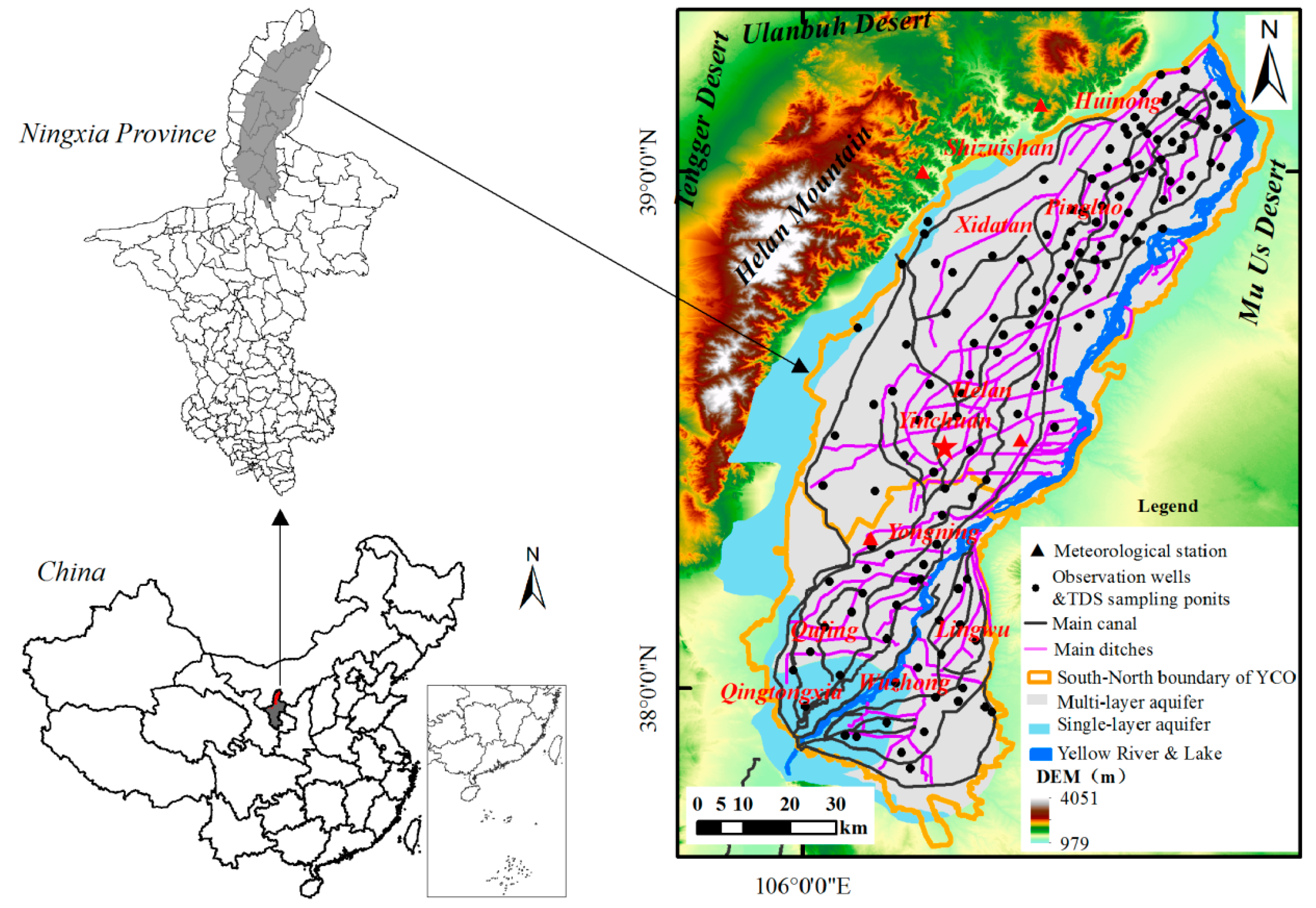


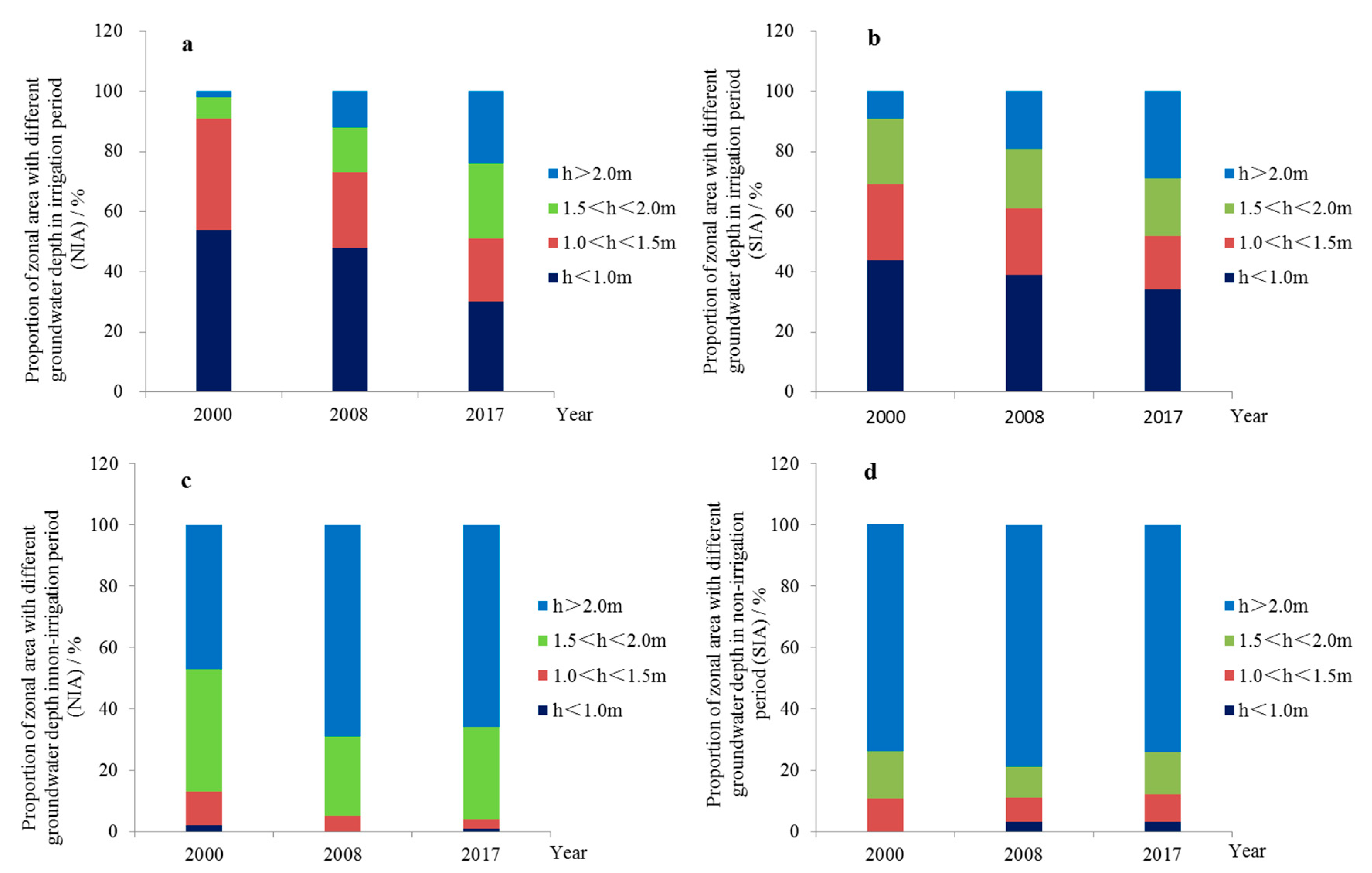
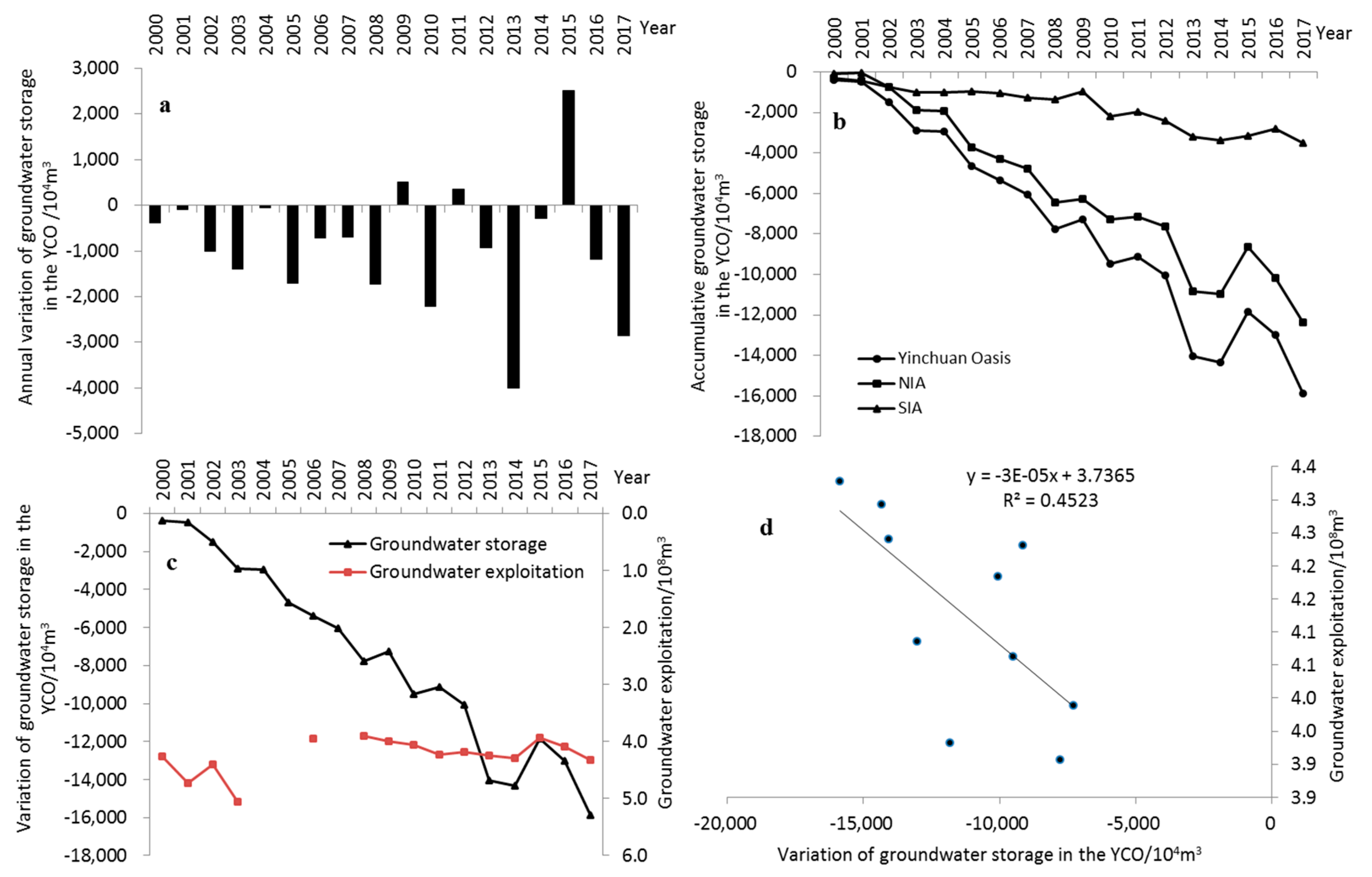
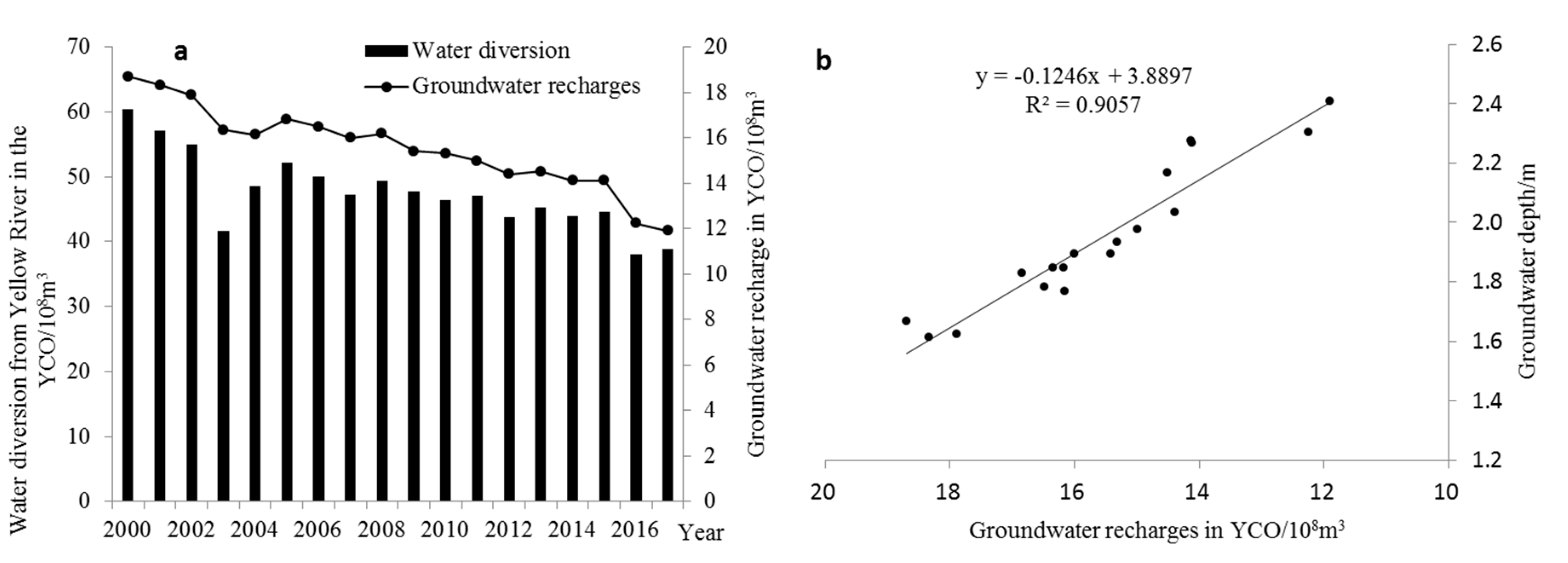
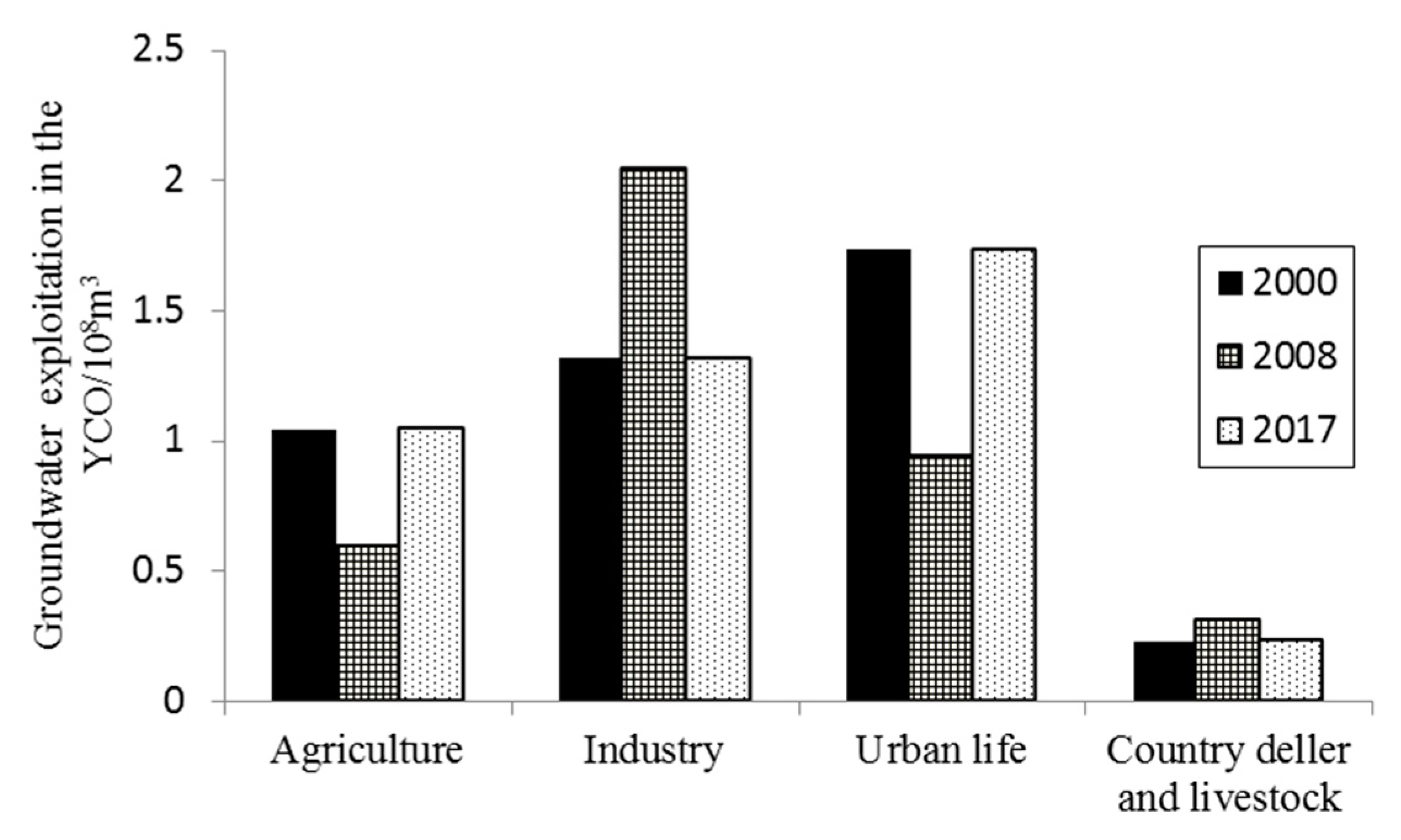
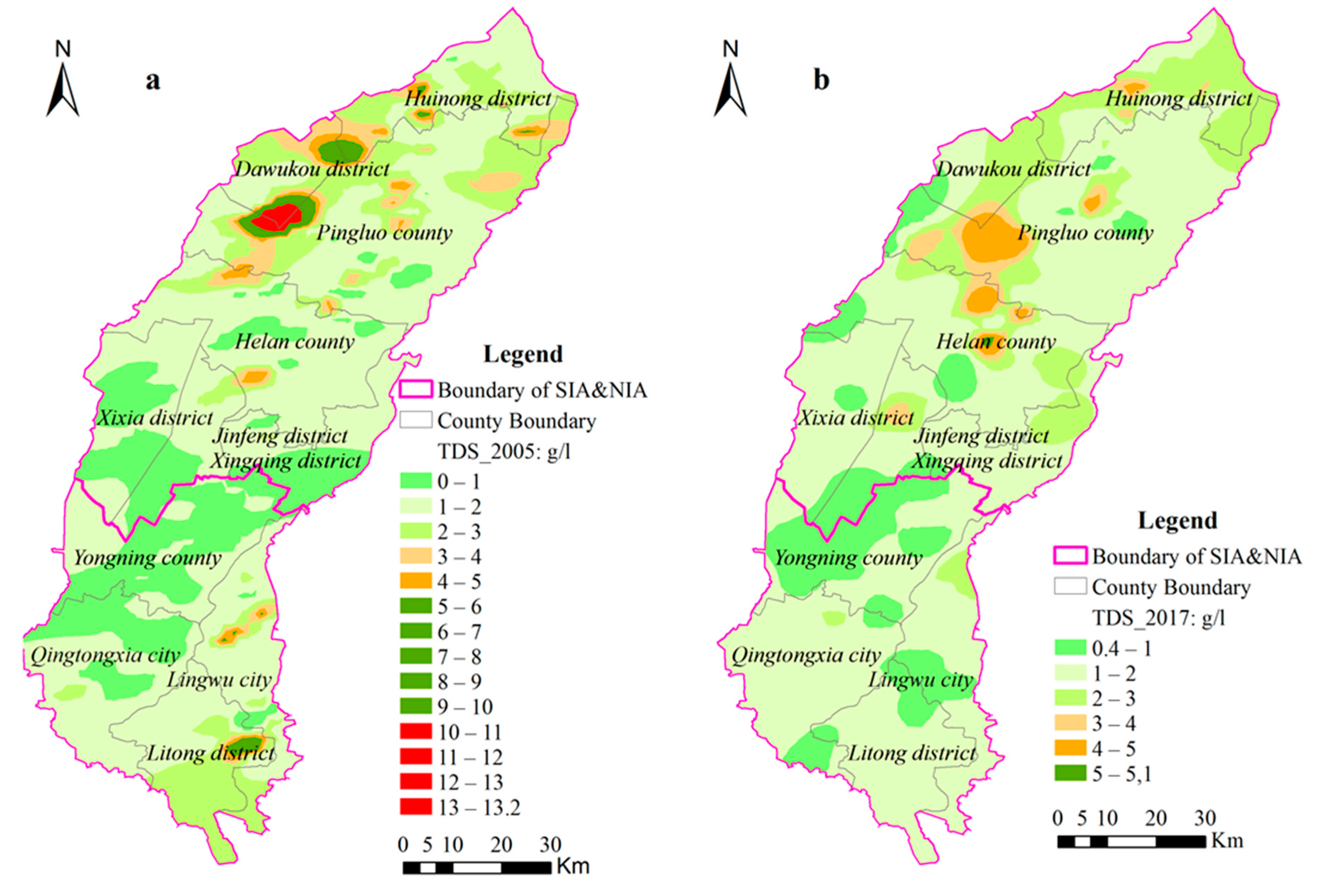
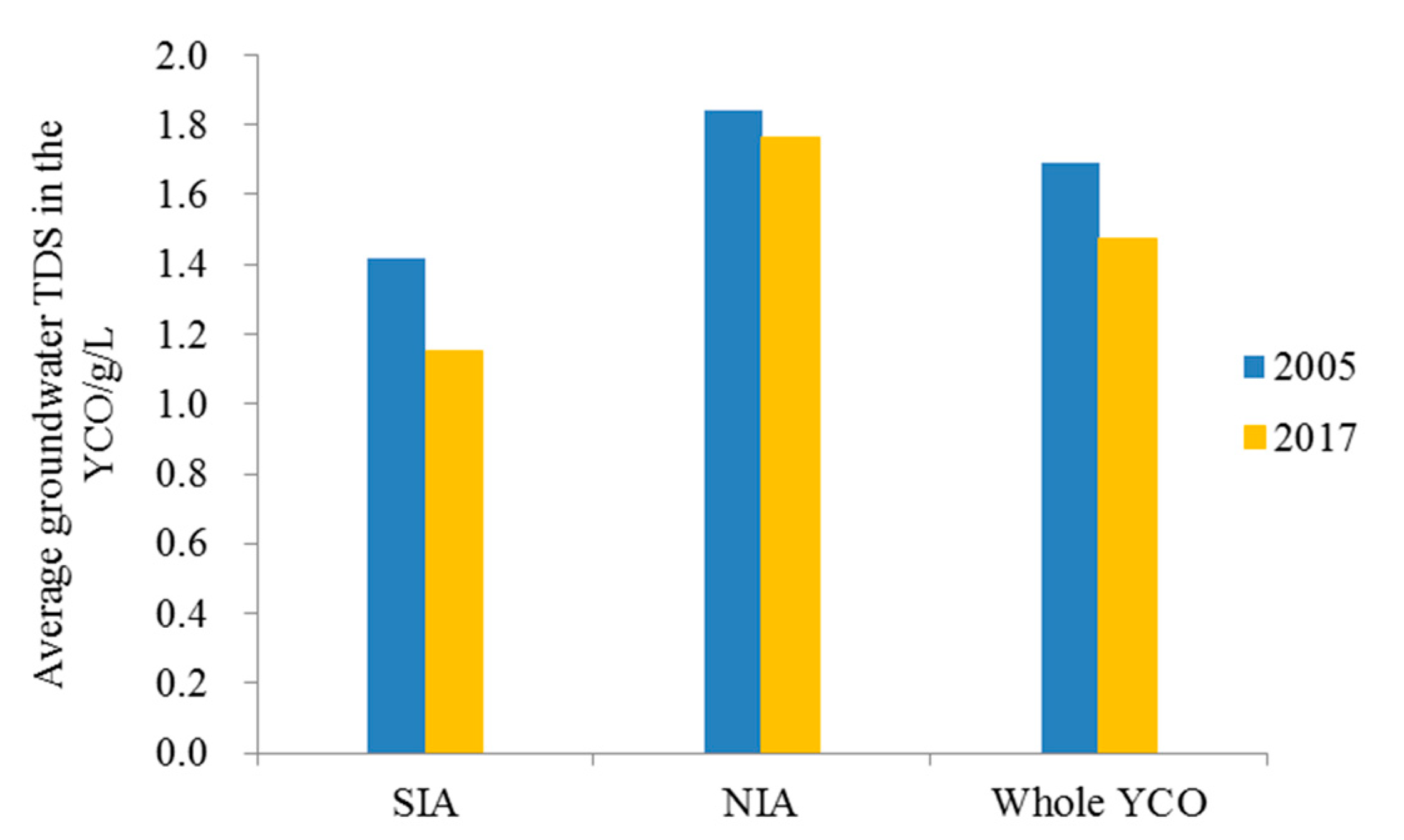
| Year | Model | Range (m) | Lag Size | Nugget (C0) | Partial Sill (C) | Spatial Correlation (C0/(C0 + C)) (%) |
|---|---|---|---|---|---|---|
| 2005 | Spherical | 19,920 | 1660 | 0.2 | 0.09 | 68.97 |
| 2017 | Spherical | 13,091 | 1873 | 0.17 | 0.11 | 60.71 |
| TDS | Mean Error (ME) | Standardized Mean Error (SME) | Root-Mean-Square Error (RMSE) | Average Standard Error (ASE) | Root-Mean-Square Standardized (RMSSE) |
|---|---|---|---|---|---|
| 2005 | −0.06 | −0.09 | 0.525 | 0.49 | 1.34 |
| 2017 | −0.01 | −0.01 | 0.46 | 0.37 | 0.91 |
| Year | District | Classification | Grade of Total Dissolved Solids | ||||
|---|---|---|---|---|---|---|---|
| <1 g·L−1 | 1–3 g·L−1 | 3–5 g·L−1 | 5–10 g·L−1 | >10 g·L−1 | |||
| 2005 | NIA | Area/km2 | 680.4 | 2940.5 | 324.8 | 77.0 | 34.9 |
| Proportion/% | 16.9 | 73.1 | 8.1 | 1.9 | 0.9 | ||
| SIA | Area/km2 | 690.7 | 1503.7 | 30.1 | 24.7 | 0.0 | |
| Proportion/% | 30.7 | 66.9 | 1.3 | 1.1 | 0.0 | ||
| 2017 | NIA | Area/km2 | 451.9 | 3272.6 | 316.5 | 16.6 | 0.0 |
| Proportion/% | 11.1 | 80.7 | 7.8 | 0.4 | 0.0 | ||
| SIA | Area/km2 | 584.7 | 1663.7 | 0.8 | 0.0 | 0.0 | |
| Proportion/% | 26.0 | 74.0 | 0.0 | 0.0 | 0.0 | ||
© 2020 by the authors. Licensee MDPI, Basel, Switzerland. This article is an open access article distributed under the terms and conditions of the Creative Commons Attribution (CC BY) license (http://creativecommons.org/licenses/by/4.0/).
Share and Cite
Mi, L.; Tian, J.; Si, J.; Chen, Y.; Li, Y.; Wang, X. Evolution of Groundwater in Yinchuan Oasis at the Upper Reaches of the Yellow River after Water-Saving Transformation and Its Driving Factors. Int. J. Environ. Res. Public Health 2020, 17, 1304. https://doi.org/10.3390/ijerph17041304
Mi L, Tian J, Si J, Chen Y, Li Y, Wang X. Evolution of Groundwater in Yinchuan Oasis at the Upper Reaches of the Yellow River after Water-Saving Transformation and Its Driving Factors. International Journal of Environmental Research and Public Health. 2020; 17(4):1304. https://doi.org/10.3390/ijerph17041304
Chicago/Turabian StyleMi, Lina, Juncang Tian, Jianning Si, Yuchun Chen, Yinghai Li, and Xinhe Wang. 2020. "Evolution of Groundwater in Yinchuan Oasis at the Upper Reaches of the Yellow River after Water-Saving Transformation and Its Driving Factors" International Journal of Environmental Research and Public Health 17, no. 4: 1304. https://doi.org/10.3390/ijerph17041304




